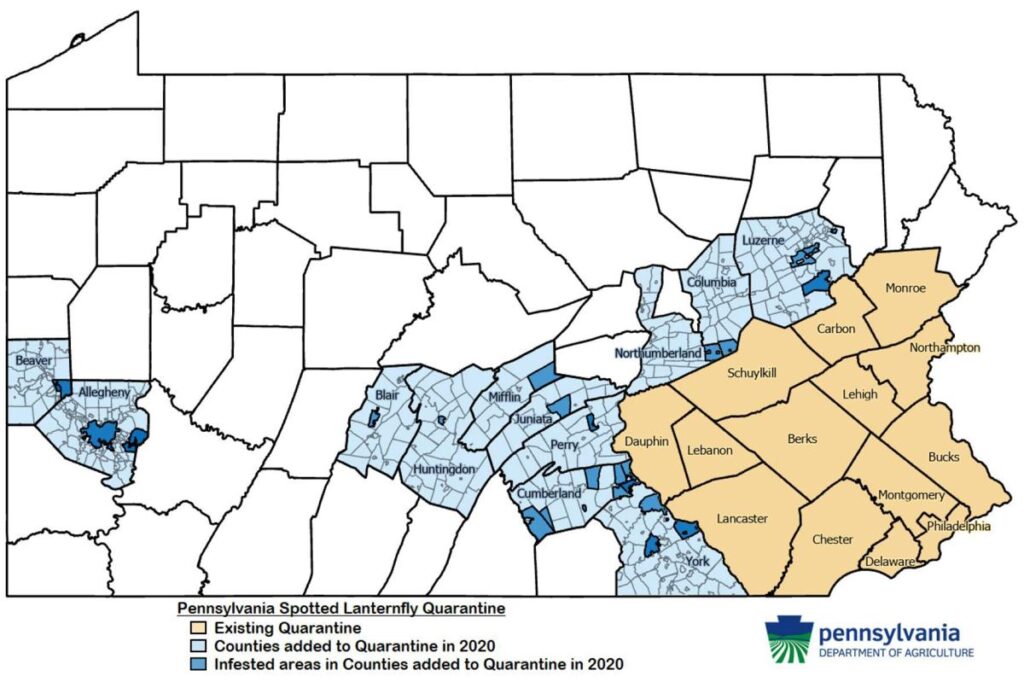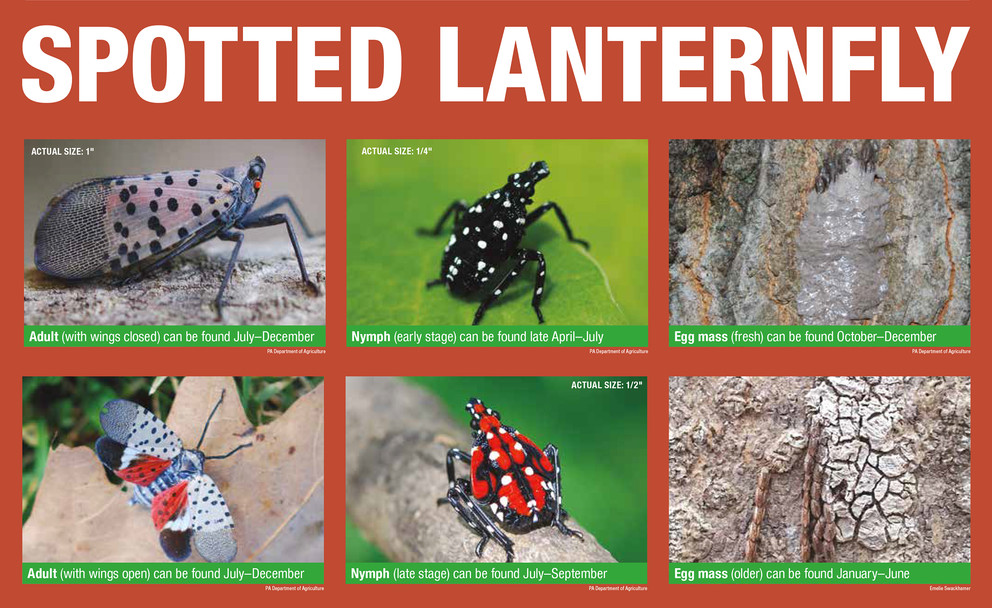After (finally) getting a Covid-19 test at the end of July and (thankfully) getting a negative result the following day, I tossed my laptop and cat in the car and drove to my parents’ house in eastern Pennsylvania right away. Over the month I spent there, I was suprised to see an overabundance of something I really had not encountered in Pittsburgh: the Spotted Lanternfly (SLF). I was truly shocked at the sheer number at my parents’ house, as I have yet to see any in western PA (though we do have them). Unfortunately it is only a matter of time before they spread, so it seemed like a good time to look into preventative maintenance.
My personal beliefs make it difficult for me to kill any bugs that are just trying to survive, including termites[1] and lanternflies, but I also understand how much damage they can create if left unchecked. It’s not something that gives me any pleasure, but it is something I do see as necessary.
What is this Bug?
The term “lanternfly” refers to several genera (plural of “genus”!) of insects that live all over the world, but the one in question is the Spotted Lanternfly (Lycorma delicatula), which is native to eastern Asian countries such as China, Taiwan, and Vietnam. Eggs typically hatch in late April / early May, and the young nymphs go through several immature, wingless stages, which are called “instars.” The first instar is black with white spots; the final instar has a red body with white spots. Adults, which have a red body and two sets of wings, can be seen as early as July. They mate and lay eggs beginning in September and through winter, when the adults die off in the cold weather. It is still unclear how cold is cold enough to kill off the eggs, based on conflicting observations in South Korea and the United States over the past decade.

Our friend L. delicatula was first recorded in 2014 in Berks County, PA, likely having come in on a shipment from its native part of the world. As you’ll see below, they can lay their eggs on a variety of surfaces, and the egg masses are easy enough to miss. Once hatched, the nymphs can feed on any plants, meaning that they can spread fairly easily as well. They are now established in the Delaware Valley (eastern PA, southwest NJ, northern DE, eastern MD, and northern VA), and spreading.[3]
Some studies indicate that adult lanternflies have a preference for the ailanthus tree, or “tree of heaven” (Ailanthus altissima), which is itself a vigorous invasive species, native to northeast and central China. However, the ailanthus is incredibly pervasive throughout North America, and while the ailanthus may be beneficial to the SLF lifecycle, it does not appear to be vital for survival. Therefore, at the present moment, it seems that the only thing preventing the spread of the spotted lanternfly is time.
While the lanternfly may prefer the tree of heaven, it can use at least 40 of our native plant species as hosts (that count was as of 2018 – the list has likely grown since then), including grapevines, apple trees, stonefruit trees, hardwood trees (e.g. black walnut and maple), hops, grain crops, and soybeans. Some grape producers reported a 90% loss of their crops in the span of one year after the appearance of lanternflies.[4]
Lanternflies can lay their eggs on almost any surface, including portable objects, such as firewood, construction debris, and outdoor furniture, which is why there is now a quarantine area across 26 Pennsylvania counties (up from the previous 14) and in multiple other states. (Unfortunately, in researching this topic, I learned that Allegheny County was added to the quarantine list this year.) Companies that move vehicles or products in or out of the quarantine zone are required to go through a permitting process to limit the potential spread.[5]

So What Can I Do?
As the adage goes, an ounce of prevention is worth a pound of cure. Vigilence is key, especially going into the fall when they begin laying eggs. Action is necessary, especially within the quarantine zone, which has been extended to where we live: [6]
- Check for symptoms of infestation: look for “plants that ooze or weep and have a fermented odor, buildup of sticky fluid (“honeydew”) on plants and on the ground underneath infested plants, and sooty mold on infested plants”
- Destroy egg masses: “when preparing for the winter holidays, check outdoor items for spotted lanternfly egg masses, including those items you may bring indoors. Scrape any egg masses into a plastic zippered bag filled with hand sanitizer, then zip the bag shut and dispose of it properly.” This YouTube tutorial is very helpful for identifying and destroying egg masses.[7]
- Report any sightings, especially if you are outside the pre-2020 quarantine area: “Use the interactive plant pest quarantine map and reporting tool [8] to see if you’re in the spotted lanternfly quarantine area or would like to report it. If you are outside of the quarantine area, report any sightings to the Pennsylvania State University Extension [9] or call 1-888-4-BADFLY (1-888-422-3359).”

Image credit: [10]
While there are some pretty heavy-duty pesticides in use to curb the spread of the spotted lanternfly, it is important to remember that those steps harm beneficial insects, such as bees and butterflies too. The French and Pickering Creeks Conservation Trust website lists some steps you can take that require a little more work but can limit the carnage specifically to the SLF: [11]
- Smush them [preferred method at my parents’ house]
- Spray with soap mix
- Capture in bottle [does not say what to do with them, but presumably various types of execution]
- Shop vac [I have seen this recommendation on other sites that also suggested putting a bleach and water mix in the reservoir to kill them once they are sucked in. We did not try this, but they were all over my parents’ grapevines, and this method sounds like the easiest way to deal with large numbers on a plant.]
- Sticky tape/duct tape on the tree
- Sticky paper [Be careful of other insects and animals that might get stuck]
- Spray with vinegar
- Plant more milkweed! [Apparently they love it and don’t know it’s poisonous, plus it’s a benefit to our friends the monarchs[12]]
- “BUG-A-SALT” salt gun [While a very amusing concept, and it has good reviews on Amazon,[13] this gun shoots table salt, which is not something I want to have in my garden]
- BB gun with no BBs [Apparently the air blast is enough to kill them – I have not seen this suggestion elsewhere]
With reports in Pennsylvania up almost 500% this year,[14] it may not be long before I’m trying these methods in my own yard. I hate to think of these insects working their way west across the state, and what massive pesticide use to halt their spread may mean for the other insects I’m actively trying to protect. Given that, our best option is to stay vigilant and educated.
~
Have you had any dealings with the SLF? Do you have any sure-fire tricks to catch, kill, and/or prevent them? I’d love to hear your suggestions below.
Thanks for reading!
[1] https://radicalmoderate.online/integrated-pest-management-termites/
[2] https://cumberlink.com/news/local/cumberland-perry-counties-added-to-spotted-lanternfly-quarantine-zone-in/article_754405a5-01d6-51fa-9927-a460eade9c36.html
[3] https://en.wikipedia.org/wiki/Spotted_lanternfly
[4] https://www.nytimes.com/2018/05/21/science/lanternflies-pennsylvania-crops.html
[5] https://www.agriculture.pa.gov/Plants_Land_Water/PlantIndustry/Entomology/spotted_lanternfly/Pages/Permitting.aspx
[6] https://www.aphis.usda.gov/aphis/resources/pests-diseases/hungry-pests/the-threat/spotted-lanternfly/spotted-lanternfly
[7] https://www.youtube.com/watch?v=WoFp_MbDiE8
[8] https://services.agriculture.pa.gov/SLFReport/
[9] https://extension.psu.edu/spotted-lanternfly
[10] https://news.psu.edu/story/585958/2019/08/30/impact/penn-state-asks-visitors-help-stop-spread-spotted-lanternfly
[11] https://frenchandpickering.org/lanternflies/
[12] https://radicalmoderate.online/monarch-101/
[13] https://www.amazon.com/Bug-A-Salt-2-0-Lawn-Garden-Model/dp/B01M173US6/#customerReviews
[14] https://www.pennlive.com/life/2020/08/spotted-lanternfly-reports-up-nearly-500-percent-in-2020.html
0 Comments